Tillandsia dugesii
Click thumbnails for full size, scaled to a new window.
Tillandsia dugesii
originally sold as T. mexicana
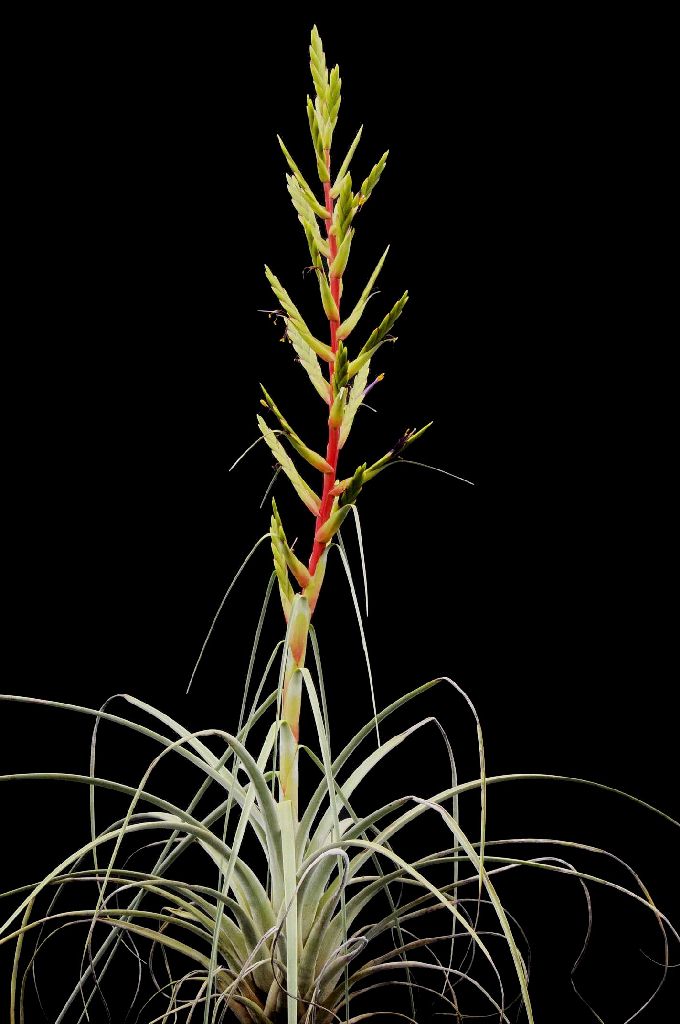
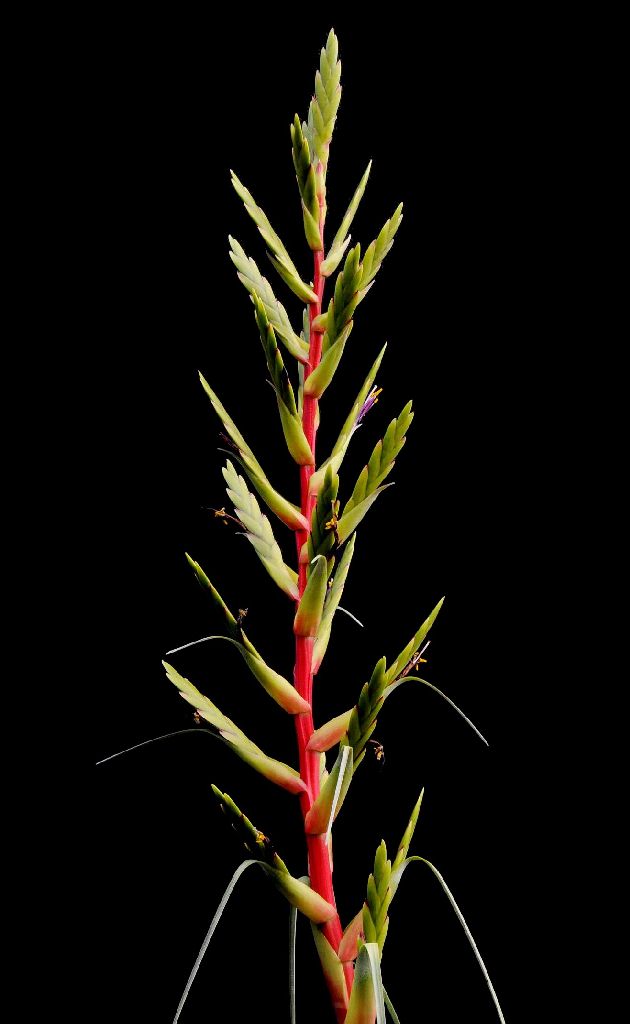
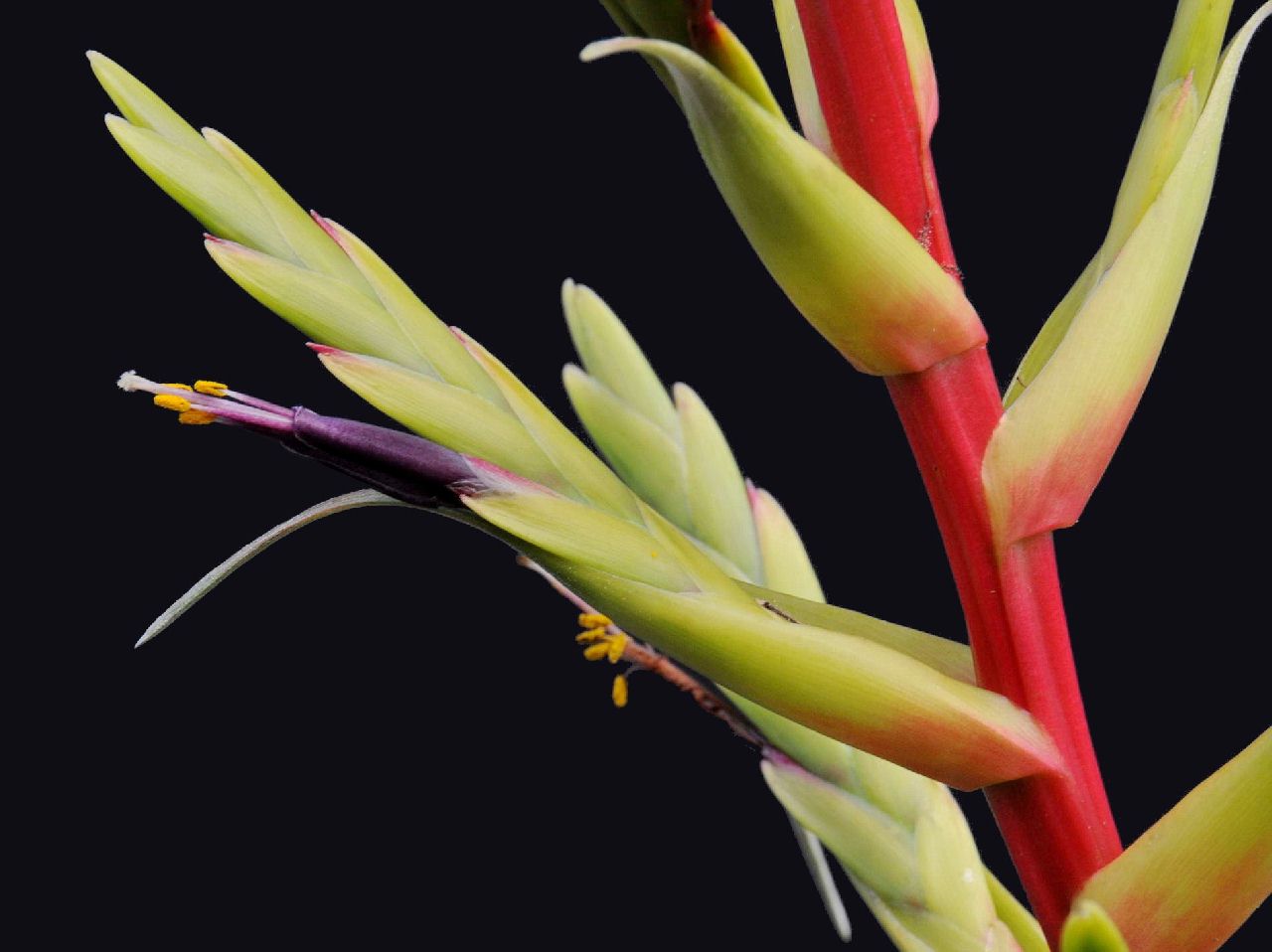
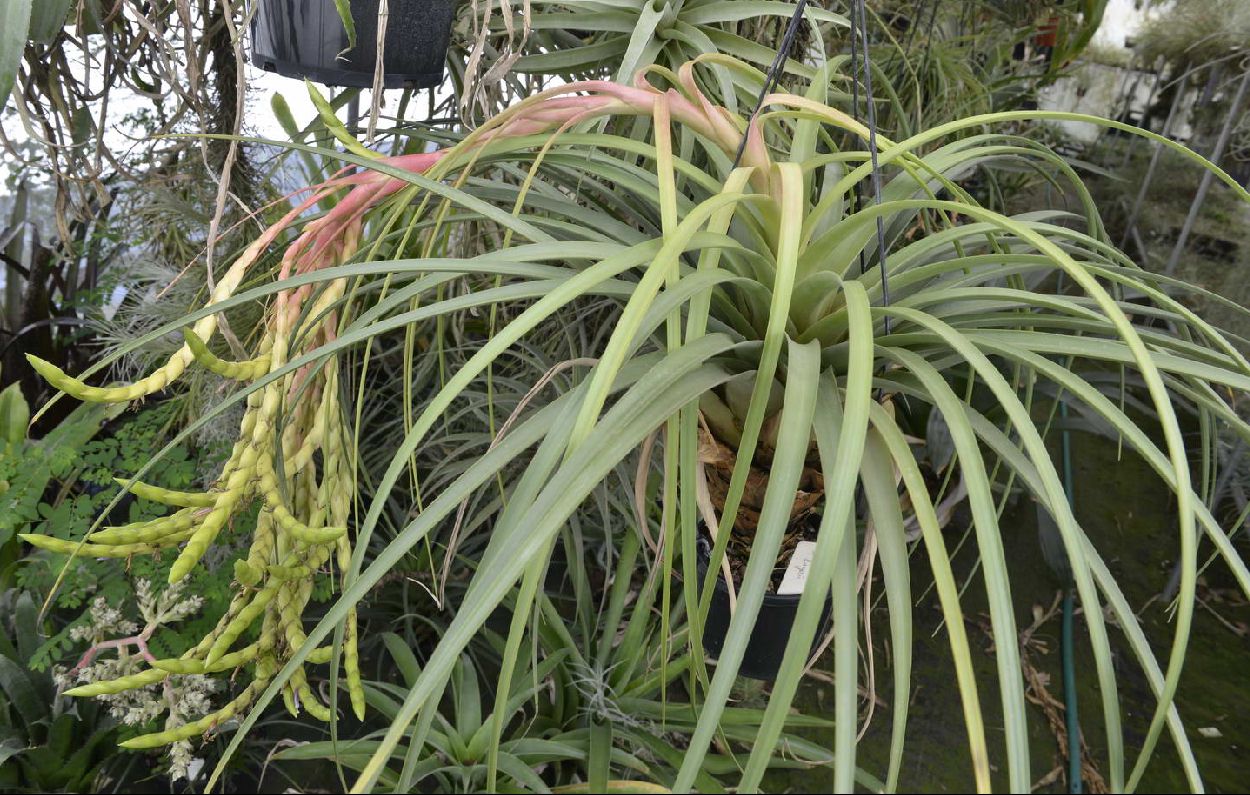
| Peter Tristram 2013 |
Peter Tristram 05/17 |
Peter Tristram ... "The first 3 pics are one of the forms of T. dugesii I bought from Lydia some years ago, photographed in 2013, long dead. No seed germinated unfortunately. I forgot that I have another much larger and greener plant that bloomed in2015/16 that Iíll post soon, which is also labelled dugesii and is producing proper pups. T. dugesii used to be available in the US trade as T. mexicana for one, so would have been in many collections. I guess theyíd all be dead now. I wonder if anyone got viable seed?
There are hybrids of these species floating around but the actual species are being lost in cultivation. Georgeís talk, at Sunnybroms and on Sunday, is pertinent about the pressing need to propagate species, not just in botanical gardens."
Peter Tristram ... "The 4th pic. is of the Ďdugesiií that is currently pupping proper pups. It has foliage more like the calothyrsus but with more substantial branches. You have to imagine the spike staying erect unless well fed or chasing the light. Maybe itís closer to T. ventanensis albeit with elongating spikes. Lots of Mexican Tills are a puzzle!"
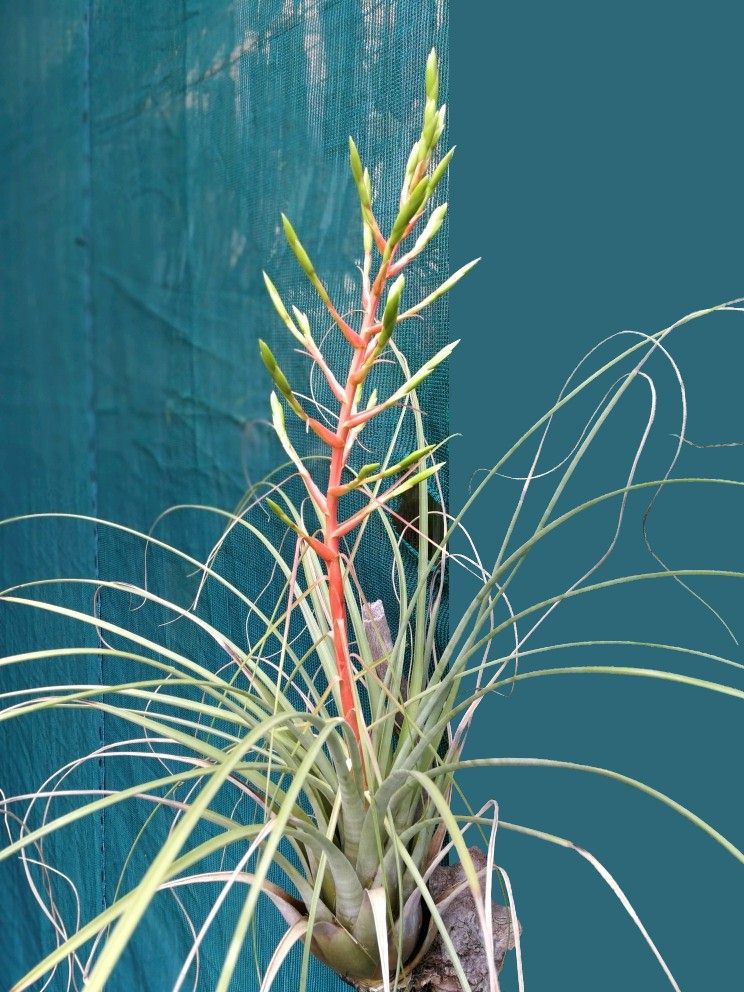 Justin Lee ... "First flowering of this plant for me. Does this plant produce offsets or should I remove the spike to try to force offsets?"
Justin Lee ... "First flowering of this plant for me. Does this plant produce offsets or should I remove the spike to try to force offsets?"
Peter Tristram ... "In my experience it rarely does, not even adventitious ones, unlike the similar calothyrsus. Itís pretty variable too. I got one from from Lydia that has produced pups but itís a marginal fit for the species though. Set seed and hope! My last blooming had plenty, though all shrunken. It was ex Lotte."
Chris Larson ... "Cutting the spike is likely to work, but not assured. But it is something to be weighed up.
Iíve been playing with Andreís keiki paste lately (https://floralaboratories.com.au/keikigrow-plant-hormones/keikigrow-plus-other-plants/) , which is applied to basal nodes, prior to flowering. It may be keiki paste, but it works not only on the flower spike but on the dormant eyes in the basal stem of the plant. He has different pastes, one better than the others for this purpose as you can see on the site. This way you can get backup pups prior to flowering for all of those plants likely to peg out after flowering.
Andre was telling me at one time that applying keiki paste before the initiation of the flower spike would in theory work better than applying it after. Though this conversation was interrupted before I could get into the reasons for this."
Tillandsia dugesii Baker, Jour. Bot. London 25: 278. 1887.
Tillandsia mexicana L. B. Smith, N. Am. Fl. 19: 140, 1938. Treated as a synonym by Gardner 1982 p137, 141 although separate species in S&D
Desc from S&D p953-5
Plant stemless, 9 dm or higher.
Leaves many in a dense rosette, strict, 8 dm long, brown, densely pruinose-lepidote with fine brown or cinereous scales;
Sheaths ovate-oblong, 1 dm long;
Blades linear-triangular, caudate-acuminate, involute-subulate toward apex, 2-3 cm wide. Scape erect, 10-15 mm in diameter, glabrous;
Scape-bracts erect, densely imbricate, broadly ovate with a long foliaceous lamina sometimes exceeding the inflorescence, coriaceous, even, lustrous, glabrous except for the densely lepidote apex and lamina.
Inflorescence compound, densely cylindric, 3-4 dm long, 5-8 cm in diameter;
Primary bracts like the upper scape-bracts, suberect, much shorter than the axillary spikes but their usually renexed laminae exceeding the lower ones;
Spikes strict, linear-lanceolate, acute, densely 10-12-flowered with a few reduced sterile bracts at the base, 8-9 cm long, 20-25 mm wide, complanate.
Floral bracts suberect, four times as long as the internodes and completely concealing the rhachis, elliptic, acute, 25-30 mm long, equaling the sepals, 15 mm broad, alate-carinate toward apex, slightly incurved but not cucullate, impressed toward the base, coriaceous, rigid, even, glabrous, lustrous, sometimes red;
Flowers subsessile.
Sepals lanceolate, acute, rigid, even, glabrous, the posterior ones carinate and much connate;
Petals linear, 4 cm long, violet;
Stamens and pistil exserted.
Type. Duges s n (holotype K, K photo 7449), Guanajuato, Mexico, 1885.
DISTRIBUTION. Epiphytic in pine or mixed woods, 400-3000 m alt, central Mexico. MEXICO. GUANAJUATO: Guanajuato, s d, Duges s n (P); 1903, s n (GH); Santa Rosa, Dec 1896, Duges s n (GH). PUEBLA: Tepoxacnill, 19 Nov 1909, Nicolas s n (P). MEXICO: Valle del Bravo, Nov 1949, Moore & Cello 5489 (BH, US); 21 Nov 1952, Matuda 27755 (MEXU, US); Amecameca, 25 Feb 1952, Matuda 28091 (MEXU, US); Mal Pais, San Nicolas, 4 Jan 1953, Matuda 29379 (MEXU, US); 29381 (MEXU, US); Dec 1954, Canada de Nanchititla, Matuda 31955 (MEXU, US). MICHOACAN: Lake Cuitzeo, 20 Jul 1892, Pringle 4173 (GH, MICH, US). OAXACA: Lachatao, Apr 1954, MacDougall 3-B (US); Chacalapa, Pochutla, 26 Sep 1965, Rzedowski 21188-A (IPMEX, US); Tequististlan, 13 Apr 1959, Van Hyning 5953 (US).
Tillandsia mexicana L. B. Smith, N. Am. Fl. 19: 140, 1938.
Treated as a synonym by Gardner 1982 p137 of T. dugesii
Desc from S&D p934-5
Plant stemless, flowering 7-8 dm high.
Leaves in a dense rosette, suberect, 4-7 dm long, very densely. and finely appressed-lepidote throughout;
Sheaths elliptic, brownish;
Blades narrowly triangular, long-attenuate, 15 Ė 20mm wide, involute toward the apex.
Scape erect, shorter than the leaves, stout;
Scape-bracts erect, imbricate, lance-elliptic, the lower ones with long foliaceous blades. Inflorescence erect, compound, densely and slenderly cylindric, 4 dm long;
Primary bracts like the upper scape-bracts, suberect, their sheaths more than half as long as the axillary spikes;
Spikes strict, subsessile, very densely 6-flowered with a few reduced sterile bracts at base, lance-ovate, 8-9 cm long, 2 cm wide, complanate.
Floral bracts erect, oblong-lanceolate, acuminate, 3-4 cm long, exceeding the sepals, carinate, coriaceous, faintly nerved and lepidote toward the apex;
Flowers subsessile.
Sepals lanceolate, acuminate, 3 cm long, subchartaceous, glabrous, the posterior ones connate and sharply carinate.
Capsules shorter than the sepals.
Type. Duges s n (holotype GH, isotype US), near Guanajuato City, Guanajuato, Mexico, Jan 1901.
DISTRIBUTION: Pine forest, 1700-2250 m all, south central Mexico
MEXICO. PUEBLA: Acatlan, 31 Mar 1957,Foster & Van Hyning 2917 (US). OAXACA: Carbonera, Oaxaca to Puebla, 10 Apr 1957, Foster & Van Hyning 2988 (US); San Miguel Suchistepec to Pochutla, 22 Sep. 1965, Rzedowski 20647 (IPMEX).
NOTES
Gardner 1982 p137, 141
A large (to a meter) epiphyteor saxicole growing along rivers in semi-arid regions of the southern Central Plateau of Mexico. I find no tillandsias near the city of Guanajuata; most forests have been cleared. I find no evidence to support maintaining T. mexicana as a distinct species.
Other material examined MEXICO, Mexico: Valle de Bravo, 1949, Moore & Cetto 5489 (BH, US), 1952, Matuda 27755(MEXU, US), Michoacan: Lake Cuitzo, 1892, Pringle 4173 (GH, MICH, US), E of Morelia, Rio Turendeo, 1977, Gardner 312 (US, SEL.). Queretaro: N of Jerecauro near dam, 1980, Gardner 1373 (US, SEL)
From R Ehlers 2/1996.
I wrote to Sue Sill(was Gardner) asking for help with T. mexicana but she never answered me. There are two forms (? species, ? varieties) in nature, one has linear long spikes and short primary bracts and the other has elliptic, broader spikes and long primary bracts (?mexicana) and occurs in Southern Mexico.
Updated 02/08/19




